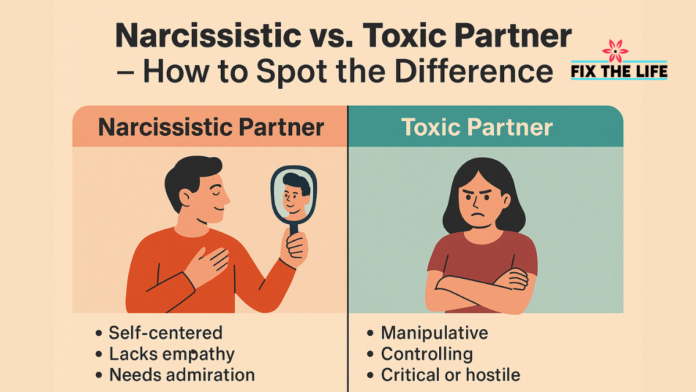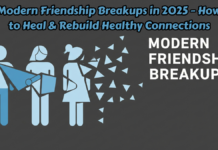Relationships can be complicated, but when emotional manipulation, control, or lack of empathy arise, they can become unhealthy. While some toxic behaviors stem from insecurity, others may be linked to narcissistic tendencies, which are more deeply rooted in personality disorders.
Understanding the difference between a narcissist vs toxic partner helps individuals recognize unhealthy patterns, set boundaries, and prioritize emotional well-being.
What Is a Narcissistic Partner?
A narcissistic partner displays traits associated with Narcissistic Personality Disorder (NPD)—a condition characterized by an inflated sense of self-importance, a lack of empathy, and a strong desire for admiration.
Key Traits of Narcissistic Partners:
- Grandiosity & Self-Importance: They constantly seek admiration and believe they are superior to others.
- Lack of Empathy: They struggle to acknowledge or care about their partner’s emotional needs.
- Manipulation & Gaslighting: They twist reality to maintain control and make their partner question their perceptions.
- Exploitation: They take advantage of others to serve their own interests.
- Entitlement: They feel they deserve special treatment and become angry when expectations aren’t met.
Example of Narcissistic Behavior:
A narcissistic partner may invalidate your emotions by dismissing concerns with statements like, “You’re overreacting” or “I never said that,” making you doubt your experiences.
What Is a Toxic Partner?
A toxic partner can exhibit harmful behaviors that damage emotional health, but they may not necessarily have narcissistic tendencies. Toxicity often stems from insecurity, poor communication, and unresolved emotional baggage rather than an ingrained personality disorder.
Key Toxic Relationship Traits:
- Lack of Healthy Communication: Frequent misunderstandings, yelling, or stonewalling.
- Jealousy & Possessiveness: Over-controlling behavior and distrust without reason.
- Blaming & Guilt-Tripping: Shifting responsibility for problems onto their partner.
- Emotional Instability: Extreme mood swings and unpredictable behavior.
- Passive-Aggressive Behavior: Avoiding direct confrontation while using subtle manipulation.
Example of Toxic Behavior:
A toxic partner may ignore boundaries by constantly checking your phone or demanding excessive reassurance.
Key Differences: Narcissist vs Toxic Partner
| Trait | Narcissistic Partner | Toxic Partner |
|---|---|---|
| Core Issue | Deep-rooted need for admiration & control | Emotional instability, insecurity, or immaturity |
| Empathy | Lack of emotional consideration | Sometimes empathetic but reacts poorly |
| Manipulation Level | Gaslighting, exploitative control | Passive-aggressive, blaming |
| Apologies & Change | Rarely takes accountability | May apologize but struggles with change |
| Intent | Self-serving, calculated | Emotionally reactive but not always intentional |
Recognizing these differences can help individuals determine whether their relationship is salvageable or requires stronger boundaries.
Red Flags in Love: Signs to Watch For
Regardless of whether your partner is narcissistic or toxic, these red flags in love indicate an unhealthy dynamic:
1. You Feel Drained Instead of Supported
Instead of uplifting you, your partner leaves you emotionally exhausted. Healthy relationships should provide emotional safety and mutual support.
2. There’s an Unequal Power Dynamic
Your opinions, feelings, or needs may feel secondary to theirs. They dominate decisions without considering your perspective.
3. Control & Isolation Tactics
They may dictate who you can interact with, make you doubt trusted friends, or discourage outside relationships.
4. Apologies Without Real Change
They might apologize frequently but never modify their behavior—showing patterns of manipulation or avoidance of accountability.
5. Gaslighting & Confusion
They make you doubt your reality, making statements like, “I never said that” or “You’re imagining things.”
How to Protect Yourself & Set Boundaries
If you recognize toxic relationship traits or suspect narcissistic manipulation, here are ways to safeguard your emotional well-being:
1. Trust Your Instincts
If something feels off, listen to your gut. Your emotions and experiences are valid.
2. Set Clear Boundaries
Define your limits and enforce them. If they continue disregarding your needs, reevaluate the relationship.
3. Limit Engagement with Manipulation
Avoid reacting emotionally to gaslighting tactics. Instead, hold firm in your truth.
4. Seek Support & Guidance
Talk to trusted friends, family, or therapists to gain clarity on your situation.
5. Know When to Walk Away
Some relationships cannot be saved. If consistent emotional harm occurs, leaving may be the best decision for your well-being.
Recommendation
How to Identify Emotional Manipulation in Any Relationship
10 Healthy Relationship Habits Every Couple Should Practice
7 Signs You’re in a One-Sided Relationship
15 Relationship Goals for Couples in 2025: Build a Stronger Bond
Who is Jenna Ortega Dating? Her Love Life and Rumored Relationship
FAQs: Common Questions About Narcissistic & Toxic Partners
Q1: Can a toxic partner change their behavior?
Yes, if they acknowledge their actions and make consistent efforts to improve. Therapy or self-awareness can lead to change.
Q2: Can narcissists have healthy relationships?
It’s challenging. Most narcissists struggle with emotional connection and accountability, making long-term healthy relationships rare.
Q3: How do I know if I’m being manipulated in my relationship?
If you constantly feel guilty, doubt your reality, or feel emotionally drained, you may be experiencing manipulation tactics.
Q4: What should I do if I suspect my partner is narcissistic?
Set firm boundaries, seek external advice, and consider whether staying in the relationship is in your best interest.
Q5: Can therapy help with toxic relationships?
Yes, therapy can provide tools for communication, boundary-setting, and emotional healing, whether you stay or leave the relationship.
Final Thought
Understanding the difference between a narcissist vs toxic partner can help individuals navigate difficult relationships with clarity. While toxicity may stem from insecurity or emotional challenges, narcissistic behavior is deeply ingrained in personality patterns.
Regardless of the cause, prioritizing emotional well-being is key—recognizing red flags in love and setting boundaries can empower individuals to seek healthy, fulfilling relationships.




